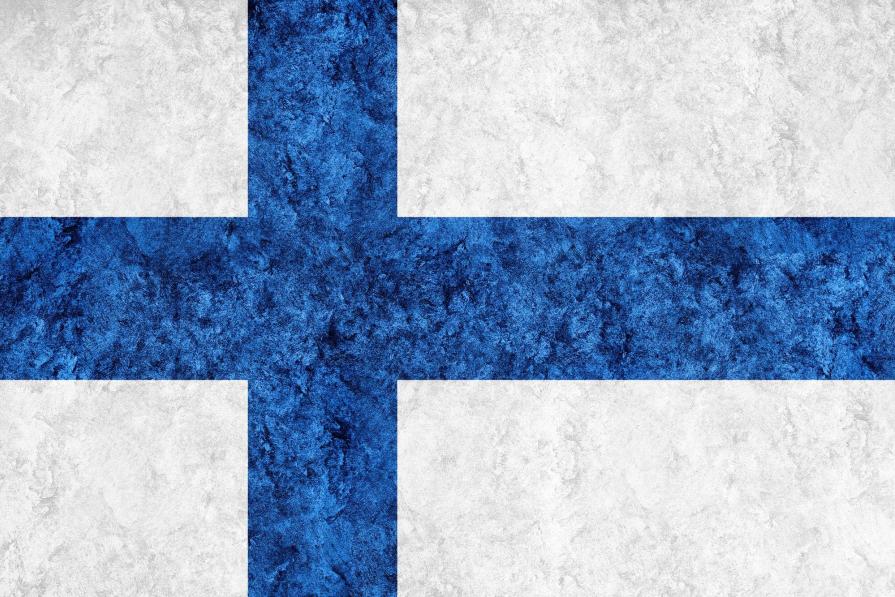The Finnish flag dates back to the beginning of the XX century. The blue Scandinavian cross symbolizes traditional Christian values, paying tribute to the geographical and symbolic kinship with neighboring countries - Sweden and Norway, which also have this symbol on the flag. It is also nicknamed the "Flag of the Blue Cross",or Siniristilippu.
There are two Finnish flags – the state (with a coat of arms in the center) and the civil one. The military uses a version with a "swallow's tail", and the presidential standard, in addition to the "tail", is also equipped with the Cross of Freedom in the upper left corner - this is the highest military order of Finland, the president of the republic concurrently also wears the signs of his master.
It was adopted after gaining independence from the Russian Empire, but its roots date back to the 40s of the XIX century. A romantic legend claims that blue symbolizes the sky and a thousand lakes, and white - snow that cover the country in winter. For centuries, this color scheme has been used in city, municipal and provincial flags.
Background
Until the XII century in Finland there was not even a hint of its flag. And then the Swedes came, conquered everything and hung everything with royal and their own banners. In 1556, the territory was granted the status of a duchy, and in 1581 - also its own coat of arms, no duchy without a coat of arms: in a scarlet shield surrounded by nine roses of silver color contained a golden lion under a crown, in the right hand of which, dressed in a plate glove, was a silver sword. At the foot is a curved Turkish saber.
Gold and red for more than three hundred years were considered the colors of the Finnish livery - that is, armorial. And at the end of the century, the shield of Finland was reflected on the royal banners of Jöhan III.

Changes came in the XVIII-XIX century, when Russia during the Northern War first conquered the entire territory of the duchy, and then rejected eastern Karelia. Almost a hundred years later, as a result of another Russian-Swedish war, the Empire under the scepter of Alexander I conquered and annexed the Duchy of Finland.
The Russian Tsar treated the Finns mercifully and generously, deciding not to turn this conquered outskirts into several imperial provinces. Instead, the Finns received autonomous status in the form of the Grand Duchy of Finland, but the emperor was proclaimed ruler directly. So, along with Poland, Finland entered with Russia in a personal union, which lasted until independence in 1917.
During the Swedish rule, the Finns had to use their flag, during the Russian there was its own, with a lion - it was used on a par with the official imperial, red and yellow received the informal status of national colors.
True, not everyone was satisfied with this - and very soon a wide discussion broke out in society and the media, the support of the nationally oriented intelligentsia was enjoyed by both these two colors and white and blue.
And the first known project was presented in 1848 at a student competition, along with the national official anthem -"Maammea". The motif was the Finnish coat of arms on a white background surrounded by a pair of laurel twigs.
The Finnish parliament – the Sejm – did not express an official position on this issue, but the enterprising liberals and socialists used those of the designs that they liked to hang over their own houses in the city and village, and a little later - for yacht clubs and societies, as the only institutions that had the right to pennants, flags and guiss of their own sample.
During the Crimean War, Finnish merchant ships sailed under the flag of St. George, based on the flag of the Imperial Customs Department. From 1861 it became official for all civilian ships, not only the commercial fleet. And the modern style with a blue cross was first used by a Finnish yacht club from Helsinki called Nyländska Jaktklubben,founded in 1861. However, between the upper crosses was the coat of arms of the province of Uusimaa under the crown, which made it look like the flag of the yachtsmen's club of the imperial capital, founded a year earlier.

In 1910, against the background of the policy of forced Russification pursued by the recent Russian Tsar Nicholas II, the flag was modified, a small tricolor was placed in the kryzh or canton, which caused protests of most Finnish citizens and even caused a boycott - the Finns used a triangular pennant with an oblique cross, thus violating the legalization of the flag.
New changes are associated with independence. The authorities held a contest, where one of several dozen options was chosen. Among the proposals, two color schemes prevailed - red-yellow, the colors of the coat of arms, and white and blue. For example, there was a proposal with a yellow cross Danebrog on a red field, or even more suitable for a hairdresser's diagonal blue and white striped flag.
Axel Gallen-Kalila made a proposal involving a white cross on a blue background, but it was rejected due to excessive similarity with the Swedish and Greek flags.
As a result, they chose a variant of the artists Eera Snelman and Bruno Tukkanen, based on a project determined by the poet Zakaris Topelius in 1860.
In 1922, when it became finally clear: the Russian Empire and the Romanovs would not return, the crown was removed from the coat of arms on the flag, Finland ceased to be a kingdom. And in 1978 the coat of arms on the shield became rectangular - that's all.
Legal restrictions
- Finnish laws prohibit the handling of the flag disrespectfully, misuse or removed without permission, not to mention damage – this is punishable by a fine of a tidy sum.
- Laws also prohibit the use of presidential or national flags without special permission, as well as adding any symbols to them, which is considered a violation of the rules for the use of the flag, as well as printing or sewing with incorrect proportions and colors.
- Wet flags should not be dried outside. He can not touch the ground, bear traces of damage or dirt (with the exception of military relics). In the event that your flag is worn out and has fallen into disrepair, it can not be thrown away - only burned or cut into many small ones, so that no one understands that these are fragments of the flag.












